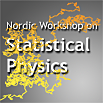Speaker
Jonas Tegenfeldt
Description
We use standard staining protocols and epifluorescence
microscopy to gain information on the local AT/GC ratio
along large DNA molecules stretched in nanoscale
channels[1]. Our development opens up a novel route to
mapping of large-scale genomic variations as well as fast
identification of rare or single cells.
With rising temperature, dark patches appear along the DNA
corresponding to AT-rich regions that lose in intensity due
to local melting of the double-stranded helix thereby
resulting in a “barcode” pattern along the DNA (Figure 1)
much like G-banding but with significantly improved
resolution, currently on the order of 1-10kbp.
Compared to standard techniques, such as paired-end
sequencing and array comparative genomic hybridization
(CGH), our technology may offer a simpler and quicker way to
identify structural variations such as deletions,
translocations, insertions and copy number variations on
scales ranging from 1kbp and up[2] on the single-molecule
level. Furthermore, the resulting "barcode" may be used for
identification of organisms, such as difficult-to-grow
fungi, bacteria and viruses.
REFERENCES
[1] Tegenfeldt, J.O., et al., The dynamics of
genomic-‐length DNA molecules in 100-‐nm channels.
Proceedings of the National Academy of Sciences of the
United States of America, 2004. 101(30): p. 10979-‐10983.
[2] Stankiewicz, P. and J.R. Lupski, Genome architecture,
rearrangements and genomic disorders. Trends in Genetics,
2002. 18(2): p. 74-‐82.

